Method for wavefield-based data processing including utilizing multiples to determine subsurface characteristics of a subsurface region
A technology of underground area and processing method, which is applied in the field of geophysical exploration, can solve the problem of false events in the output image, and achieve the effect of avoiding artifacts
- Summary
- Abstract
- Description
- Claims
- Application Information
AI Technical Summary
Problems solved by technology
Method used
Image
Examples
Embodiment Construction
[0025] figure 1 Flowchart 10 illustrates one embodiment of the invention. This embodiment includes a wavefield-based data processing method that includes utilizing multiples to obtain properties of a subsurface region of interest. The method includes obtaining an earth model and a migration model 12 related to the subsurface region of interest. The method further includes determining, for the earth model and for the migration model, a simulated geometry 14 associated with the subsurface region of interest, and forward propagating at least one wavefield 16 in the earth model from at least one excitation source obtained from the simulated geometry . The method also includes forward propagating at least one wavefield 18 in the migration model from the same source obtained from the simulated geometry, and backpropagating in the earth model using at least one receiver position obtained from the simulated geometry At least one wave field 20. The method additionally includes dete...
PUM
 Login to View More
Login to View More Abstract
Description
Claims
Application Information
 Login to View More
Login to View More - R&D Engineer
- R&D Manager
- IP Professional
- Industry Leading Data Capabilities
- Powerful AI technology
- Patent DNA Extraction
Browse by: Latest US Patents, China's latest patents, Technical Efficacy Thesaurus, Application Domain, Technology Topic, Popular Technical Reports.
© 2024 PatSnap. All rights reserved.Legal|Privacy policy|Modern Slavery Act Transparency Statement|Sitemap|About US| Contact US: help@patsnap.com










